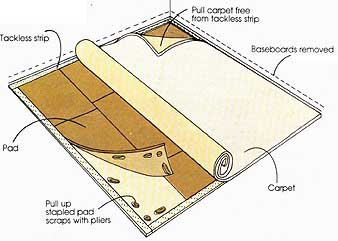Removing Existing Flooring
For some flooring installations, you will want to pull up an existing finish floor before installing the new material. In all cases, use care in removing old flooring. Some materials, such as broken ceramic tiles, are sharp; others, like carpet or wood, have numerous staples or nails. Also, despite frequent cleaning, floors attract years of household dust and grime, so wear gloves and a dust mask for protection. Finally, so that you won’t have to repair them later, avoid damaging walls, baseboards, or the subfloor as you re move the existing flooring material. Removing Wood Flooring Most wood strip flooring is nailed down and can be pried up with a curved wrecking bar or flat bar. Before prying up plank flooring, bore out any plugs and re move the screws used for additional fastening. Then, remove any moldings and/or baseboards. Insert a prybar under the first floorboard and force it up. If there is not enough room for the prybar, cut out a section of the first board with a circular saw. Set its blade depth to cut through the finish flooring only—not into the subfloor below. Remove the cut section; then insert the prybar into the opening and pry up the rest of the board. Proceed across the floor, prying up one board at a time. Work down the length of each board, placing the bar directly under the blind-nailing positions. If the wood flooring has been glued down, remove it by placing a chisel or prybar against the bottom of each piece and tapping with a hammer to pop the flooring loose, piece by piece. Removing Resilient Flooring If the sheet flooring is stapled or glued only around the room’s edges, pry up the staples or loosen the glued sheet with a wide putty knife or floor scraper. Roll it up and haul it out of the room. If the sheet was glued down all over, first cut it into 12- or 24-inch strips. Then work each strip free as described above. To pop off individual loose tiles, use a prybar or putty knife. Heat tightly bonded tiles with an iron and then pry up. To remove any remaining adhesive, use a floor scraper or putty knife, or dissolve the residue with hot soapy water, or acetone, mineral spirits, or a similar commercial product. In some localities you can rent a floor stripping ma chine for removing resilient flooring. If you have difficulty removing the flooring, consider taking up the underlayment as well. Use a circular saw to cut the floor into 4-foot by 4-foot sections. Set the blade depth to the thickness of the sheet, plus the thickness of the underlayment. You will cut through nails, so use an old or disposable blade and wear eye protectors and a respirator. Pry up each section of flooring and underlayment together, and remove. Note: Existing resilient flooring may contain asbestos fibers, which are harmful if inhaled. They are embedded in the material, but could be released if you sand, cut, or break it.
Removing Ceramic and Masonry Tiles To remove mastic installations, use a hammer and cold chisel to chip out the grout around one tile, Break the tile with a hammer and remove the pieces. Then position the cold chisel under adjacent tile edges, tap to loosen, and remove them one by one, Scrape any remaining adhesive from the subfloor. To remove mortar-bed installations, it is generally easier to force up the mortar bed itself than to break the tiles away from it. Insert a large wrecking bar or pick axe under one corner of the mortar bed and pry it up from the subfloor. Use a sledgehammer to break the bed into sections, and wire cutters or snips to cut the reinforcing mesh embedded in the mortar. Remember that carefully aimed taps are more effective than indiscriminant blows. Avoid excessive force and wear protective goggles and clothing. Removing Carpet To remove carpet installed on tackless strip, remove all metal edgings and cut the carpet into 1- or 2-foot-wide bands with a utility knife. Using a screwdriver or prybar, pry up one carpet corner and pull it free from the strip along both walls. Release all the bands in the same way. If you want to keep the carpet in one piece, release one corner and work your way around all the walls. To remove carpet installed with carpet tacks, slide a flat prybar under one edge of the carpet and pry up several tacks. Then tug hard and pull up the entire car pet, tacks and all. If that doesn’t work, loosen each tack with a prybar. Roll up the carpet and haul it away. To remove stapled pads, tear away whatever you can, pull up the remaining small pieces, and pry up staples from the subfloor with a screwdriver or pliers. Remove the tackless strip with a prybar. To remove cushion-backed carpet which has been glued down, cut it into 12-inch-wide bands. Use a wide putty knife to work each band free from the subsurface, as you pull them up. Scrape of f any remaining chunks of foam and adhesive. If the floor must be smooth, sand of f the residue with a rented floor sander, or install an underlayment.
Prev.: Getting the Room Ready for Floor Installation |
Saturday, 2011-04-02 15:43


